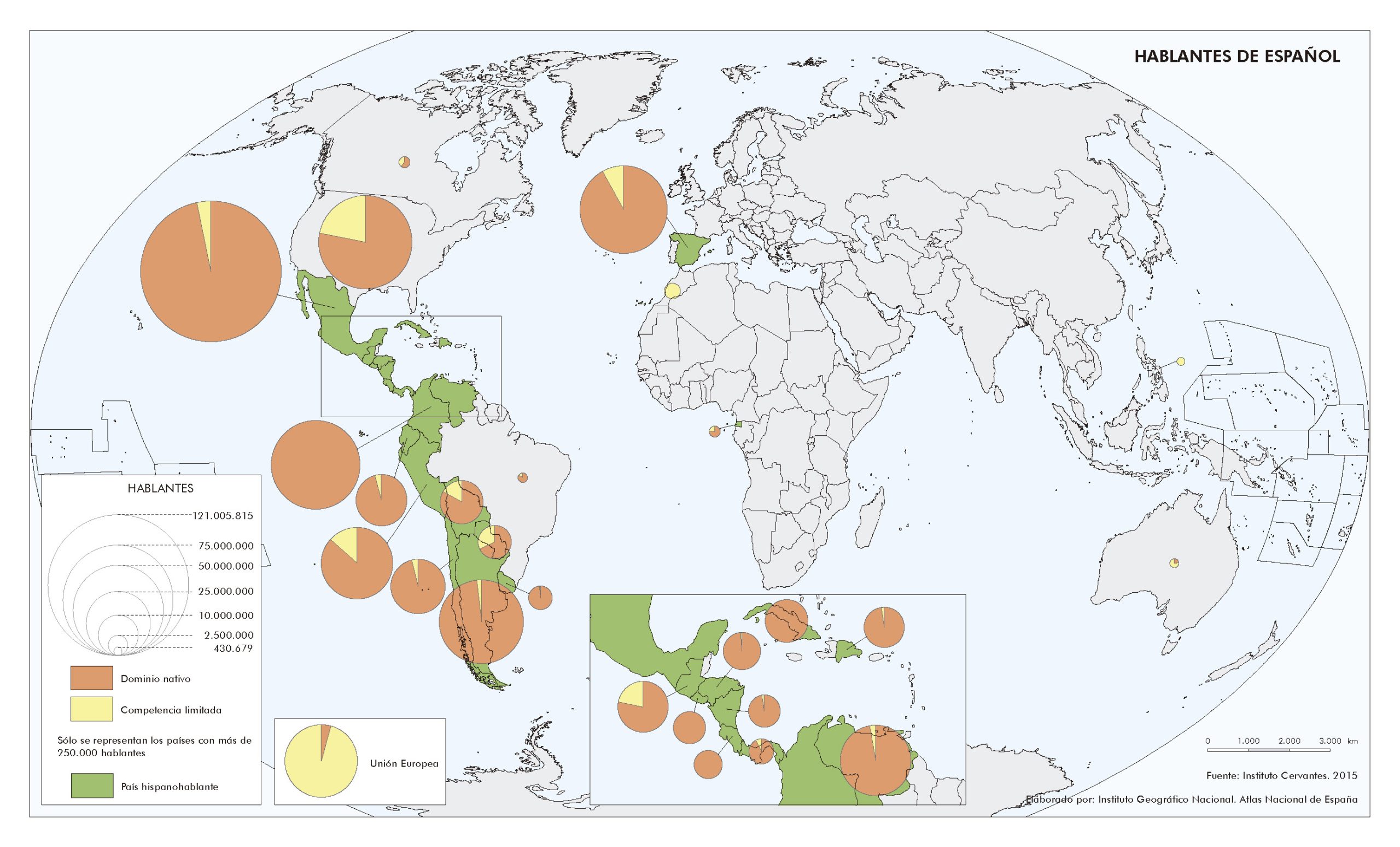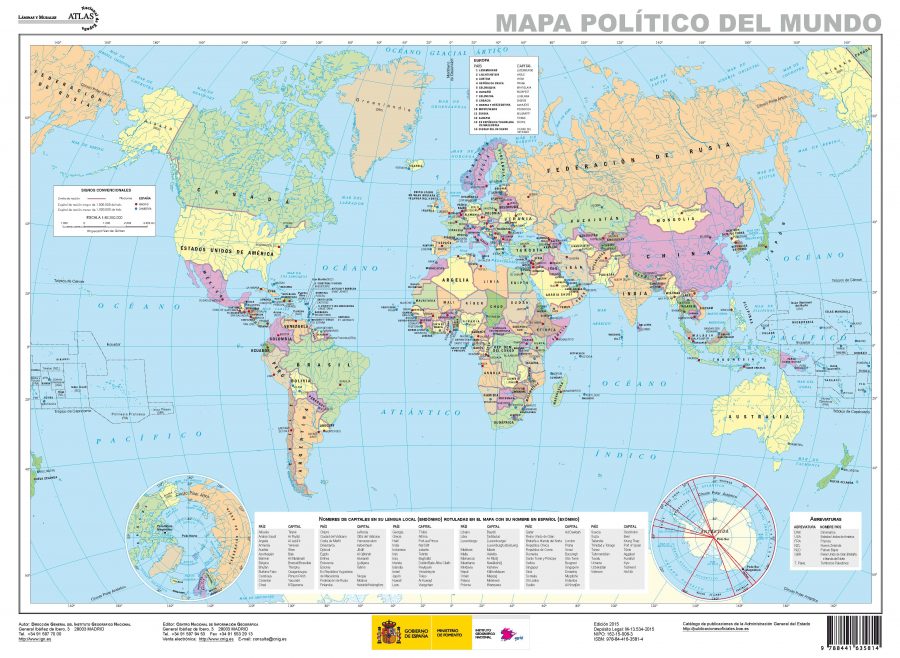El mundo hispanohablante
El mundo hispanohablante se refiere a los países y regiones donde hay una población significante que habla español. Según el Instituto Cervantes, el 7,8 por ciento de la población mundial era hispanohablante en 2016 y esta cifra está aumentando. Además, el español es el segundo idioma más hablado como idioma nativo. Para comparar, el chino-mandarín es el tercer idioma más hablado en el mundo.
Sabemos que en muchos países de América Latina se habla español, pero hay varias regiones que podemos considerar hispanohablantes a causa de su población de hablantes. En el mapa abajo, aparecen los países donde hay más de 250.000 hispanohablantes. Por eso, el mapa incluye los países como Estados Unidos, Filipinas, Marruecos y Australia. Aunque el español originalmente es de España, la diáspora latinoamericana contemporánea transforma ciudades en el mundo. En Australia los hispanohablantes vienen principalmente del Cono Sur—Argentina, Uruguay y Chile (Martín). En Israel y Turquía, se intenta conservar el ladino. El ladino es una variedad de español hablada en la comunidad sefardí, una comunidad judeoespañola expulsada de España en 1492 (Ventas). También, hay varios países no hispanohablantes donde los estudiantes aprenden español por la educación formal, en institutos de idiomas y a través de las telenovelas latinoamericanas (“Unidos por las telenovelas“). Es decir, hay un mundo hispanohablante oficial y una multitud de rincones hispanohablantes no oficiales en el globo.
-

“Hablantes de español. Mapa” by Instituto Geográfico Nacional with data from Instituto Cervantes under CC BY 4.0 For an enlarged map use Hablantes de español.
Comprensión
¿Verdadero o falso?
Decide si las oraciones son verdaderas o falsas. Corrige las oraciones falsas.
- Seis por ciento de la población mundial es hispanohablante.
- El chino-mandarín es el tercer idioma más hablado como idioma nativo.
- Se habla español en países no oficialmente hispanohablantes.
- El origen del idioma español es México.
- El Cono Sur se refiere a los países de Nuevo México, Texas y Arizona.
- El ladino es un idioma judeoespañol.
- No se aprende español en regiones no hispanohablantes.
A pensar
You can easily recognize that most South American and Central American countries have Spanish as an official language. Now look at the continents of Africa and Asia. What countries surprise you?
- In Spanish, list the names of three countries outside of the Americas where Spanish is spoken.
- How do you think Spanish arrived in these countries? A guess is fine.

Use Mapa político del mundo for an enlarged version.
Las nacionalidades hispanohablantes
Let’s learn the names of the countries, capitals, and nationalities of el mundo hispanohablante. The countries in the list below are all former colonies of Spain (España), which is how the Spanish language arrived in these countries.
In your notebook, write a chart like the one below or use Nacionalidades Graphic Organizer to print one.
*¡Ojo! “(s)” or “(es)” indicates the plural form, whereas “o/a” indicates the feminine/masculine form.
| País | Capital | Nacionalidad |
| Argentina | Buenos Aires | |
| La Paz y Sucre | boliviano(s) / boliviana(s) | |
| Cuba | La Habana | |
| Chile | Santiago de Chile | |
| Bogotá | colombiano(s) / colombiana(s) | |
| Costa Rica | costarricense(s) | |
| El Salvador | salvadoreño(s) / salvadoreña(s) | |
| Ecuador | ||
| Madrid | español(es), española(s) | |
| Filipinas | Manila | filipino(s) / filipina(s) |
| Guatemala | Ciudad de Guatemala | |
| Guinea Ecuatorial | ecuatoguineano(s) / ecuatoguineana(s) | |
| Tegucigalpa (Distrito Central) | hondureño(s) / hondureña(s) | |
| México | Ciudad de México (D.F.) | |
| Managua | nicaragüense(s) | |
| Panamá | Ciudad de Panamá | |
| Paraguay | paraguayo(s) / paraguaya(s) | |
| Lima | peruano(s) / peruana(s) | |
| Puerto Rico | San Juan | |
| República Dominicana | dominicano(s) / dominicana(s) | |
| Sahara Occidental | El Aaiún y Tifariti | saharaui(s) |
| Montevideo | uruguayo(s) / uruguaya(s) | |
| Venezuela | Caracas |
Now watch the video Países donde se habla español to fill in the missing information.
You will have noticed in the video that the speaker gives the nationalities in the singular masculine, singular feminine, plural masculine, and plural feminine forms. Because nationalities are adjectives (e.g. Puerto Rican, Mexican), they must agree in number and gender.
Learn more about adjective agreement by watching the video Gender with people/nationalities.
Personas, productos y prácticas
In pairs, take turns asking about the nationality of the people, products, or practices in each sentence. Make sure there is number and gender agreement.
Modelo: La música bachata es ______________. (República Dominicana)
Estudiante 1: ¿Cuál es la nacionalidad de la música bachata?
Estudiante 2: La música bachata es dominicana.
- Salma Hayek y María Félix son _______________. (México)
- Cardi B es ________________. (Estados Unidos)
- La marca Zara es ________________. (España)
- Ricky Martín y Luis Fonsi son ________________. (Puerto Rico)
- Las pirámides son _______________. (Guatemala)
- Mi mejor amiga es _______________. (Venezuela)
*¡Ojo! You will need to change mi to a different possessive adjective.
Hablando de la nacionalidad
To talk about your nationality, you can give your country of origin or you can give your nationality. We can also talk about products and practices in terms of nationalities and in terms of country origin.
Examples:
- Somos estadounidenses.
- Soy de Estados Unidos.
- El tango es un baile de Argentina.
- El tango y el malambo son bailes argentinos.
The verb we need to talk about the country of origin or nationality of a person, product, or practice is ser (to be). You already learned one of its forms in the first lesson (son); you’ll find that form plus two others in the table below. Listen to the video and fill in the missing forms on the left of the table.
| Ser = To be |
|
|---|---|
| yo (I) | nosotros (we) somos nosotras (we) somos |
| tú (you, informal) | vosotros* (you all, informal, Spain) sois vosotras* (you all, informal, Spain) sois |
| él (he) ella (she) usted (you, formal) |
ellos (they) son ellas (they) son ustedes (you all) son |
*Your instructor may require you to learn vosotros and vosotras.
Watch the video below: Where Are You From? to learn more.
El Día de la Hispanidad
En Estados Unidos, las escuelas típicamente celebran el Día de Cristóbal Colón (Christopher Columbus) como día festivo. Hay mucha polémica sobre la fiesta porque la llegada de Cristóbal Colón a las Américas inició la colonización, por consiguiente el maltrato de los pueblos indígenas. Además, Colón no descubrió las Américas porque ya había civilizaciones en las islas del Caribe donde primero llegó. En varios países del mundo hispanohablante se conoce el 12 de octubre como el Día de la Hispanidad para celebrar el punto de encuentro actual entre los latinoamericanos, españoles, ecuatoguineanos y otros grupos hispanohablantes en el mundo sin olvidarse de la violencia de la historia colonial. Es una oportunidad de compartir la diversidad del mundo hispano. Por eso, esta fiesta universal no se llama Cristóbal Colón en español.
Comprensión
Grammar: Los cognados
Looking at suffixes can help you recognize cognates (words with a similar sound, appearance, and meaning in two languages). In Spanish, the suffixes -dad and -tad denote a feminine word. In many cases, these suffixes can be translated as -ty or -ity in English.
-
- la comunidad (community), las comunidades (communities)
- la publicidad (publicity)
The suffixes -ción and -ión also denote a feminine word.
-
- la nación, las naciones (nation, nations)
- la región, las regiones (region, regions)
Let’s put this into practice.
- Can you transform these adjectives into nouns? Hint: These words are in the text and end with -dad or -tad.
-
- hispano:
- diverso:
- oportuno:
- Can you guess what the following words are in Spanish? Hint: Add the suffix -ción or -ión.
-
- civilization:
- interpretation:
¿Verdadero o falso?
Decide si la oración es correcta o falsa. Corrige las oraciones falsas.
- La llegada de Cristóbal Colón a Europa inició la colonización española.
- Colón primero llegó a las islas del Caribe.
- El Día de Hispanidad se celebra el 12 de septiembre.
- El Día de Hispanidad es una oportunidad de hablar de las diferencias y similitudes en el mundo hispanohablante.
A pensar
What ideas and images come to mind when you compare these two names for the holiday we celebrate on October 12th? Write down everything you can think of.
- Columbus Day
- Hispanic Heritage Day
La hispanidad
Write a sentence in Spanish that defines la hispanidad. Don’t worry about grammar at this point. You can use one or more of these words:
- la identidad
- hispano/a
- hispanohablante
- la cultura
“América invertida”
When we see la hispanidad from a perspective other than that of the Spanish empire, we can see the world with a different lens.
Joaquín Torres Garcia fue un artista uruguayo de padres españoles. Torres García inventó el término “constructivismo universal” para describir su arte vanguardista. El constructivismo es la idea de que las personas construyen el mundo a través de sus percepciones y observaciones (Wikipedia). Nuestra imaginación también crea el mundo.

Comprensión
Completar
Completa las oraciones sobre “América invertida” usando el vocabulario. You may need to use words you learned in an earlier lesson.
- Joaquín Torres García fue un artista ____________.
- Los padres de Torres García eran ___________.
- El constructivismo es la idea de crear ____________ a través de la __________, la __________ y la imaginación.
- El Polo Sur está _____________ y el _____________ está abajo.
- El sol está _______________ y la luna está a la derecha.
A pensar
En grupos pequeños, discute las preguntas de reflexión.
- What is the point of Torres García’s upside-down map of South America?
- Why is there a point marked with a cross on the drawing?
- What does the sun on the top left above two ships reveal?
After completing this theme, I can …
- in Spanish, name Spanish-speaking countries or countries with significant Spanish-speaking populations in South America, North America, Central America, the Caribbean, Africa, Asia, and Europe.
- in English, explain two ways how Spanish has become a global language.
- in Spanish, state the nationality of people, products, and practices using the verb ser in a complete sentence.
- in Spanish, describe the global holiday El Día de Hispanidad.
- in English, explain how El Día de Hispanidad does not really translate as Columbus Day.
- in English, interpret the meaning of Joaquín Torres García’s drawing “América invertida.”


